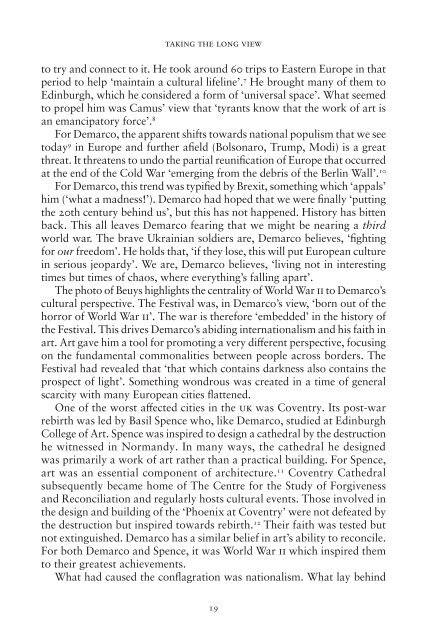Demarco's Edinburgh by Richard Demarco and Roddy Martine sampler
In this fascinating book, Richard – the 2013 UK recipient of the Citizen of Europe medal – explores the original world vision of Sir John Falconer and Rudolph Bing and, with Roddy, recalls the highs and lows of The Edinburgh International Festival, The Fringe, Art, Book, Jazz and Television Festivals, and The Royal Edinburgh Military Tattoo.
In this fascinating book, Richard – the 2013 UK recipient of the Citizen of Europe medal – explores the original world vision of Sir John Falconer and Rudolph Bing and, with Roddy, recalls the highs and lows of The Edinburgh International Festival, The Fringe, Art, Book, Jazz and Television Festivals, and The Royal Edinburgh Military Tattoo.
Create successful ePaper yourself
Turn your PDF publications into a flip-book with our unique Google optimized e-Paper software.
Taking the Long View<br />
to try <strong>and</strong> connect to it. He took around 60 trips to Eastern Europe in that<br />
period to help ‘maintain a cultural lifeline’. 7 He brought many of them to<br />
<strong>Edinburgh</strong>, which he considered a form of ‘universal space’. What seemed<br />
to propel him was Camus’ view that ‘tyrants know that the work of art is<br />
an emancipatory force’. 8<br />
For <strong>Demarco</strong>, the apparent shifts towards national populism that we see<br />
today 9 in Europe <strong>and</strong> further afield (Bolsonaro, Trump, Modi) is a great<br />
threat. It threatens to undo the partial reunification of Europe that occurred<br />
at the end of the Cold War ‘emerging from the debris of the Berlin Wall’. 10<br />
For <strong>Demarco</strong>, this trend was typified <strong>by</strong> Brexit, something which ‘appals’<br />
him (‘what a madness!’). <strong>Demarco</strong> had hoped that we were finally ‘putting<br />
the 20th century behind us’, but this has not happened. History has bitten<br />
back. This all leaves <strong>Demarco</strong> fearing that we might be nearing a third<br />
world war. The brave Ukrainian soldiers are, <strong>Demarco</strong> believes, ‘fighting<br />
for our freedom’. He holds that, ‘if they lose, this will put European culture<br />
in serious jeopardy’. We are, <strong>Demarco</strong> believes, ‘living not in interesting<br />
times but times of chaos, where everything’s falling apart’.<br />
The photo of Beuys highlights the centrality of World War II to <strong>Demarco</strong>’s<br />
cultural perspective. The Festival was, in <strong>Demarco</strong>’s view, ‘born out of the<br />
horror of World War II’. The war is therefore ‘embedded’ in the history of<br />
the Festival. This drives <strong>Demarco</strong>’s abiding internationalism <strong>and</strong> his faith in<br />
art. Art gave him a tool for promoting a very different perspective, focusing<br />
on the fundamental commonalities between people across borders. The<br />
Festival had revealed that ‘that which contains darkness also contains the<br />
prospect of light’. Something wondrous was created in a time of general<br />
scarcity with many European cities flattened.<br />
One of the worst affected cities in the UK was Coventry. Its post-war<br />
rebirth was led <strong>by</strong> Basil Spence who, like <strong>Demarco</strong>, studied at <strong>Edinburgh</strong><br />
College of Art. Spence was inspired to design a cathedral <strong>by</strong> the destruction<br />
he witnessed in Norm<strong>and</strong>y. In many ways, the cathedral he designed<br />
was primarily a work of art rather than a practical building. For Spence,<br />
art was an essential component of architecture. 11 Coventry Cathedral<br />
subsequently became home of The Centre for the Study of Forgiveness<br />
<strong>and</strong> Reconciliation <strong>and</strong> regularly hosts cultural events. Those involved in<br />
the design <strong>and</strong> building of the ‘Phoenix at Coventry’ were not defeated <strong>by</strong><br />
the destruction but inspired towards rebirth. 12 Their faith was tested but<br />
not extinguished. <strong>Demarco</strong> has a similar belief in art’s ability to reconcile.<br />
For both <strong>Demarco</strong> <strong>and</strong> Spence, it was World War II which inspired them<br />
to their greatest achievements.<br />
What had caused the conflagration was nationalism. What lay behind<br />
19


















